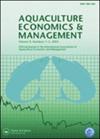Economic contribution of the U.S. catfish industry
IF 3.7
2区 经济学
Q1 AGRICULTURAL ECONOMICS & POLICY
引用次数: 15
Abstract
Abstract The catfish industry is the largest U.S. aquaculture sector and a major contributor to the rural economies of the Southern states of Alabama, Arkansas, and Mississippi. Economic contributions of this industry to the tristate region were estimated using an input-output modeling approach with the IMPLAN database and software (Impact Analysis for Planning MIG, Inc.). An analysis-by-parts approach was employed as the IMPLAN database does not disaggregate the catfish sector from other livestock industries which have expenditure patterns that differ substantially from those of catfish. All major actors of the catfish industry, i.e. feed mills, hatcheries, foodfish farms, and processing plants, were surveyed to obtain their expenditure patterns and output in terms of sales. Data were obtained from 68 farms (hatcheries and foodfish combined), four feed mills, and eight processing plants in the tristate region. Sales and expenditure values were converted to coefficients employing standard enterprise budgeting techniques and imported to the IMPLAN model for estimating industry contributions during 2019. The direct output from the catfish industry ($1.10 billion) generated a total economic contribution of $1.91 billion. The industry directly employed 4,298 people and created an additional 4,868 jobs in the tristate economy for a total employment effect of 9,166 jobs. Catfish industry spending created an indirect economic effect of $552 million in other secondary sectors that supplied production inputs and services. The induced economic effect generated from household spending amounted to $254 million. Some of the key sectors influenced by the catfish industry were grain farming, banking and financial institutions, truck transportation services, electricity generation, equipment, and machinery manufacturing. The industry also generated $78 million in local, state, and federal taxes. This study provides critical insights for policymakers and others into the contribution of the U.S. farm-raised catfish industry to local and regional economies as well as its diverse-industry interconnections.美国鲶鱼产业的经济贡献
鲶鱼产业是美国最大的水产养殖部门,也是南部阿拉巴马州、阿肯色州和密西西比州农村经济的主要贡献者。该行业对三州地区的经济贡献是使用IMPLAN数据库和软件(MIG公司规划影响分析)的投入产出建模方法来估计的。采用了部分分析方法,因为IMPLAN数据库没有将鲶鱼部门与其他畜牧业分开,这些畜牧业的支出模式与鲶鱼的支出模式有很大不同。对鲶鱼产业的所有主要参与者,即饲料加工厂、孵化场、食用鱼养殖场和加工厂进行了调查,以获得其支出模式和销售产出。数据来自三州地区的68个养殖场(孵化场和食用鱼的总和)、4个饲料加工厂和8个加工厂。采用标准企业预算技术将销售额和支出值转换为系数,并导入IMPLAN模型,用于估算2019年的行业贡献。鲶鱼产业的直接产出(11亿美元)产生了19.1亿美元的总经济贡献。该行业直接雇用了4298人,并在三州经济中创造了4868个工作岗位,总就业效应为9166个工作岗位。鲶鱼产业支出为提供生产投入和服务的其他第二产业创造了5.52亿美元的间接经济效应。家庭开支所产生的经济效应达2.54亿美元。受鲶鱼产业影响的一些关键部门包括粮食种植、银行和金融机构、卡车运输服务、发电、设备和机械制造。该行业还创造了7800万美元的地方、州和联邦税收。这项研究为政策制定者和其他人提供了重要的见解,帮助他们了解美国农场养殖鲶鱼产业对当地和区域经济的贡献,以及它与不同行业的相互联系。
本文章由计算机程序翻译,如有差异,请以英文原文为准。
求助全文
约1分钟内获得全文
求助全文
来源期刊

Aquaculture Economics & Management
FISHERIES-
CiteScore
7.30
自引率
17.90%
发文量
21
期刊介绍:
Aquaculture Economics and Management is a peer-reviewed, international journal which aims to encourage the application of economic analysis to the management, modeling, and planning of aquaculture in public and private sectors. The journal publishes original, high quality papers related to all aspects of aquaculture economics and management including aquaculture production and farm management, innovation and technology adoption, processing and distribution, marketing, consumer behavior and pricing, international trade, policy analysis, and the role of aquaculture in food security, livelihoods, and environmental management. Papers are peer reviewed and evaluated for their scientific merits and contributions.
 求助内容:
求助内容: 应助结果提醒方式:
应助结果提醒方式:


